Sun Valley Gold sells Vista Gold (VGZ) shares worth $2.16 million
Multiple longer-term indicators suggest that we still may not have seen a cycle top in Bitcoin yet. To the topside, the next levels to watch are at $118K (the 127.2% Fibonacci extension of the Q1 correction) and $131K (161.8%).
Bitcoin Key Points
- Bitcoin saw an impressive rally in Q2, more than erasing Q1’s -30% downdraft to test record highs in the $110K area.
- Multiple longer-term indicators suggest that we still may not have seen a cycle top in Bitcoin yet.
- To the topside, the next levels to watch are at $118K (the 127.2% Fibonacci extension of the Q1 correction) and $131K (161.8%).
Bitcoin H1 2025 in Review
In our Q2 outlook, we noted that the current (at the time) -30% drawdown was “NOT out of character for a mid-cycle dip” and that it “would actually mark the smallest pullback that we’ve seen in any Bitcoin cycle to date.” Those stay-the-course notes played out in spades through the second quarter of the year, when Bitcoin bottomed near $75K in early April and eventually went on to hit record highs above $110K, where they continue to consolidated as of writing in early July.
Below, we break down the outlook for the king of the cryptocurrencies and highlight relevant fundamental and technical trends that will drive Bitcoin in the second half of the year.
Bitcoin H2 2025 Outlook
Many analysts have identified a reliable 4-year cycle centered around the Bitcoin Halving that suggests we’re still within a potentially bullish period.
For the uninitiated, the Bitcoin Halving is when the reward for mining new bitcoins is cut in half. This reduces the rate at which new bitcoins are created and thus, lowers the total supply of new bitcoins coming into the market.
The halving tends to increase scarcity and historically has led to an increase in the price of bitcoin, though, of course, it’s not guaranteed to do so in the future. As any Bitcoin bull will tell you, the April 2024 halving took the “inflation rate” of Bitcoin’s supply to below 1% per year, less than half of gold’s annual inflation rate.
Looking at my favorite chart, which I colloquially call “The Only Bitcoin Chart You’ll Ever Need™”, previous Bitcoin halvings have marked the transition from the (yellow) post-bottom recovery rally stage to the (green) full-blown bull market stage.
As Bitcoin continues to mature as an asset class, we’re likely to see smaller percentage moves in each stage even if the general pattern continues to hold (i.e. a 29X rally off the lows like we saw in 2016-17 would take Bitcoin over $2,000,000 for an absurd market capitalization of $40T), but the time-based projection for a ~1.5-year bull cycle to late 2025 is developing generally in-line with the 4-year cycle: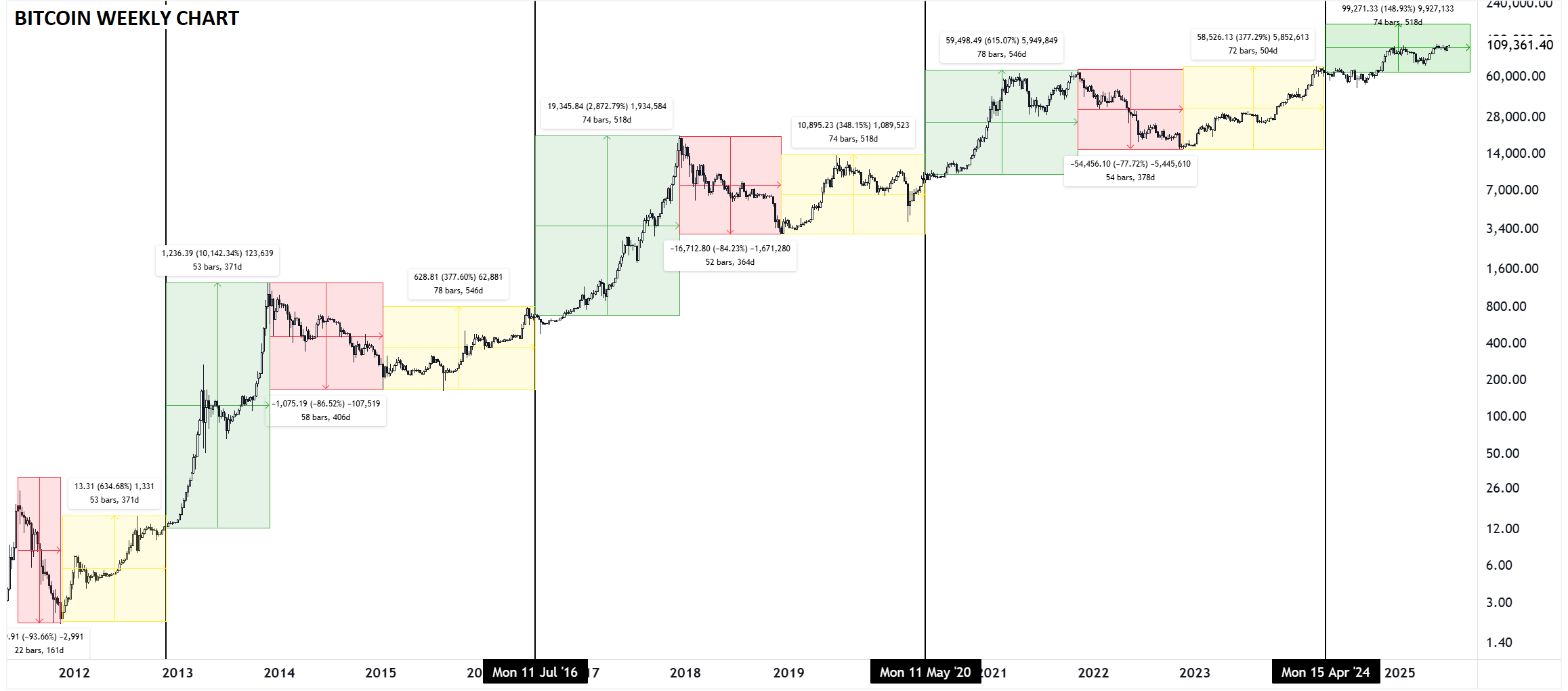
Source: TradingView, StoneX. Past performance is no guarantee of future returns.
As we noted in our last report, there are both macroeconomic and “fundamental” bullish arguments for Bitcoin beyond this simple cycle analysis, though it’s critical to watch how those catalysts evolve in the coming quarter and beyond.
From a macroeconomic perspective, the monetary policy backdrop remains generally supportive, though we may be nearing peak easing globally. As the chart below shows, global central banks have still been cutting interest rates generally, but we have seen that trend stalling in recent months, with major central banks like the ECB expected to slow (but not necessarily stop) interest rate reductions in the coming months: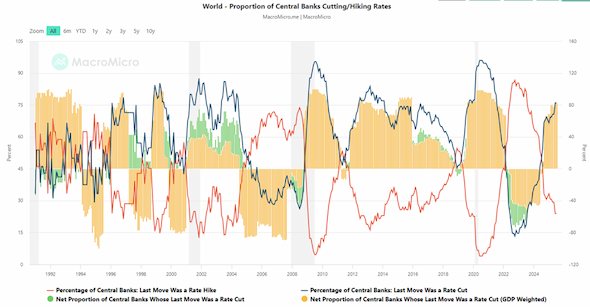
Source: MacroMicro
Looking ahead, the risk that central banks shift focus back to the risks of re-accelerating inflation may develop into a potential headwind for Bitcoin in the latter half of the year, especially with fiscal policy (government spending and tax cuts) becoming more accommodative.
In that vein, the growth rate of fiat money in the financial system has turned to a more stimulative direction. So-called “M2” is central banks’ estimate of the total money supply, including all the cash people have on hand, plus all the money deposited in checking accounts, savings accounts, and other short-term saving vehicles such as certificates of deposit (CDs).
After falling to around 1% in the first half of 2024, the year-over-year growth in global money supply has re-accelerated over the last few months and is running back above 8% as we go to press: 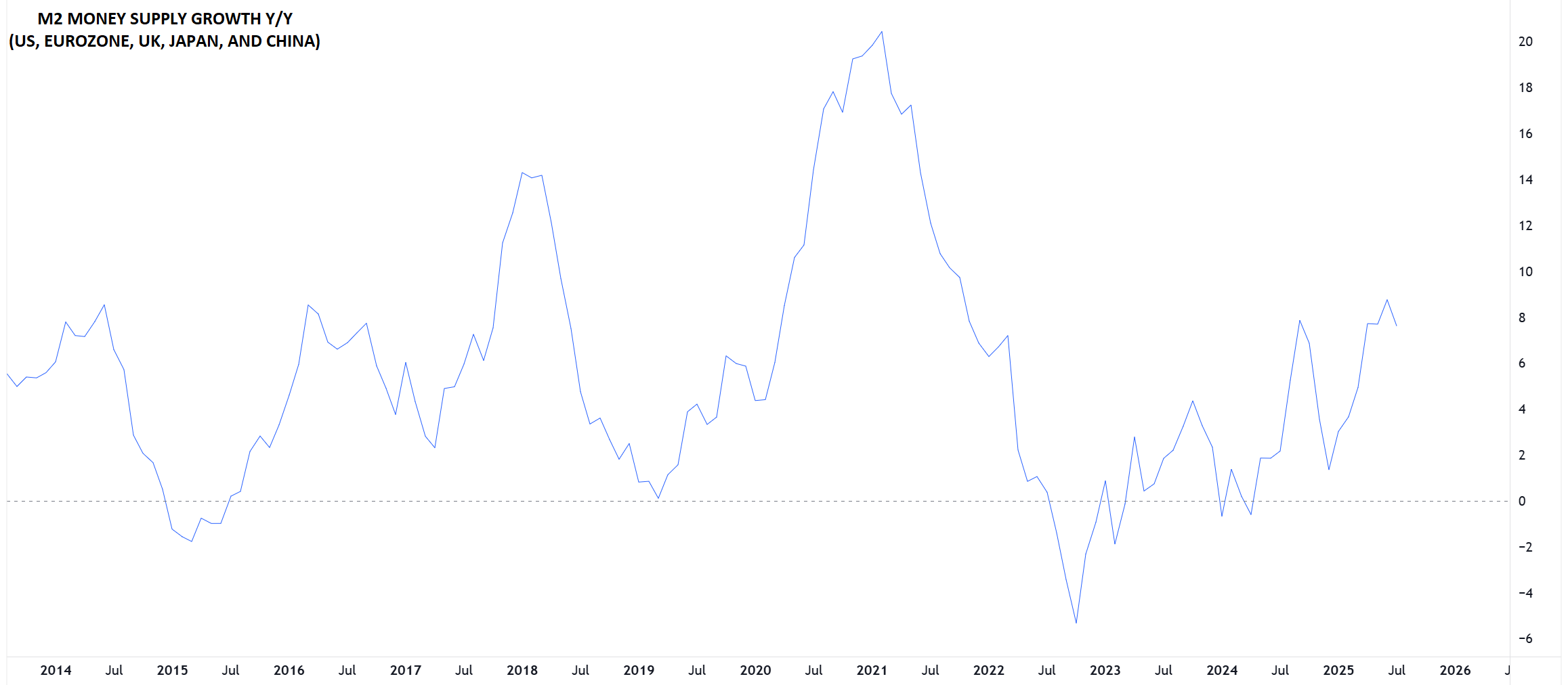
Source: TradingView, StoneX.
One of the key narratives driving Bitcoin’s value is the idea of “hard money” or a hedge against fiat currency debasement, and as long as the global supply of money continues to increase, that theme could put a floor under the cryptocurrency’s price.
Beyond broad macroeconomic dynamics, we’ve also increasingly seen large financial entities accumulating Bitcoin at an increasing rate. In addition to the growing popularity of firms accumulating the cryptocurrency as a treasury asset, we’ve also seen impressive inflows from “TradFi” institutional investors buying spot Bitcoin ETFs, with total inflows into Bitcoin ETFs now nearing $50B:
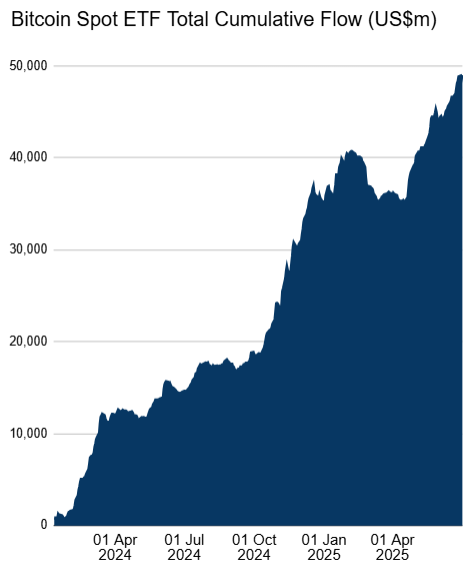
Source: Farside Investors
As long as we continue to see the secular trend of “TradFi” ETF purchases continuing in the coming months, downside dips in Bitcoin may be more limited than they have in the past.
Why Bitcoin Likely Has Not Reached a Cycle Top (Quite) Yet
Over a longer-term horizon, there are plenty of indicators that suggest we may still be some distance away, in both time and price, from a cycle top in Bitcoin.
As we noted in the introduction, the ~-32% peak-to-trough pullback we saw in Q1 would actually mark the smallest pullback that we’ve seen in any Bitcoin cycle to date, consistent with a maturing asset class that is seeing increasing institutional adoption:

Source: Glassnode
In other words, a 30-50% drop is still “normal” mid-cycle behavior for Bitcoin historically; it’s only if we start to see a move below $55K that long-term investors may start to get spooked.
From a valuation perspective, the MVRV (Market Value to Realized Value) Z-score, which compares the current price to the aggregate cost paid for all outstanding Bitcoin, sits near 2.3, up from the
However, as the chart below shows, previous cycle tops haven’t formed until this indicator reaches levels above 7, suggesting that we may still have further to rally before reaching a cycle top (though given Bitcoin’s limited historic record, it’s important to remember that the current cycle may not necessarily match previous patterns):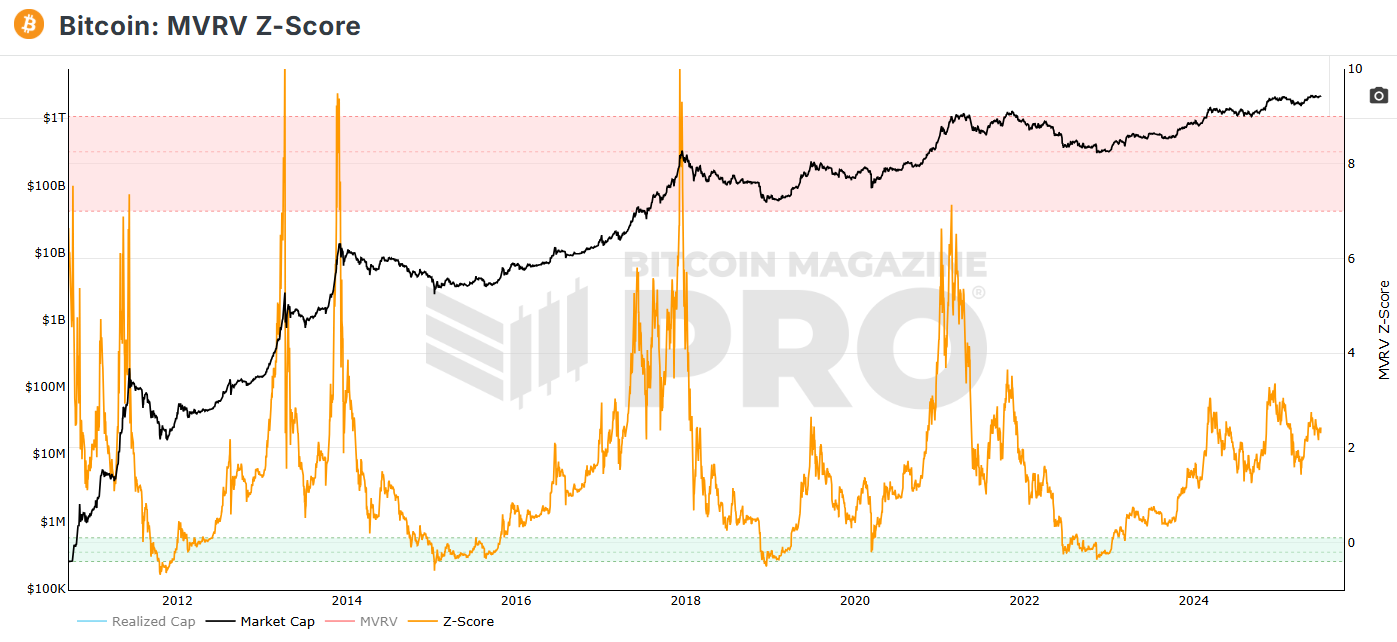
Source: Bitcoin Magazine. Past performance is not indicative of future returns.
A final consideration is the behavior of long-term holders. As we’ve noted in previous outlooks, those who have held their Bitcoin for more than a year, almost tautologically, are not trying to make a “quick buck” off the cryptocurrency; rather they are more likely to be “true believers” or “HODLers” who are unlikely to sell unless they’re sitting on a truly massive gain.
As the chart below shows, the proportion of Bitcoin that has been held for at least a year started 2024 at record highs above 70% before seeing a notable decline to below 63% at the end of last year, where it remains midway through 2025. While that -7% drop may seem relatively small, it represents nearly 1.4M in marginal Bitcoin supply, weighing on the Bitcoin price.
This measure, by definition, moves relatively slowly, but any renewed selling from longer-term “HODLers” may offset inflows into ETFs as we move through the second half of the year: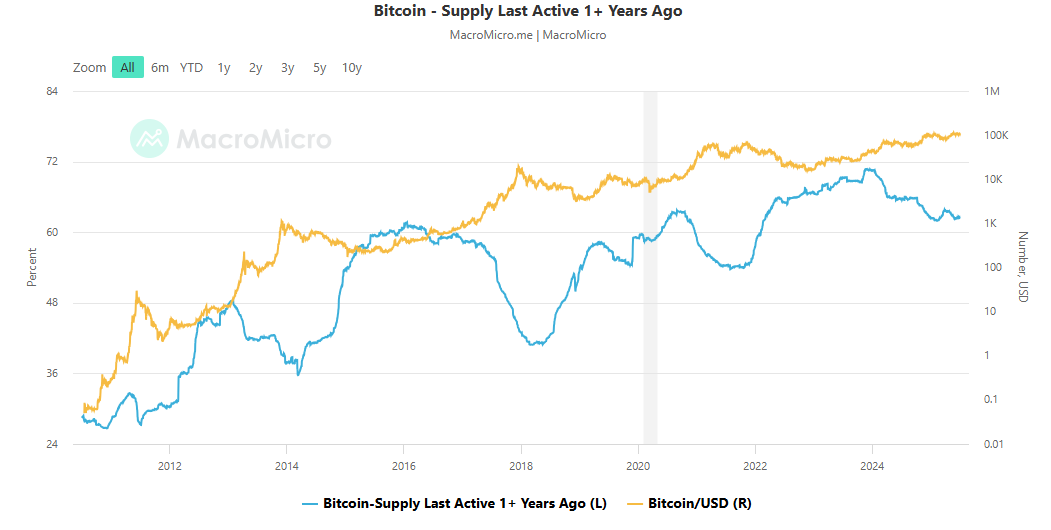
Source: MacroMicro.me
Of course, the catalysts we highlight in this report may not play out as expected, and to some extent, they may already be priced in, so readers should always exercise caution when trading Bitcoin and other cryptoassets. As ever, it will be critical to monitor a broad swath of macroeconomic and crypto-specific metrics as the year develops.
Bitcoin Technical Analysis – BTC/USD Weekly Chart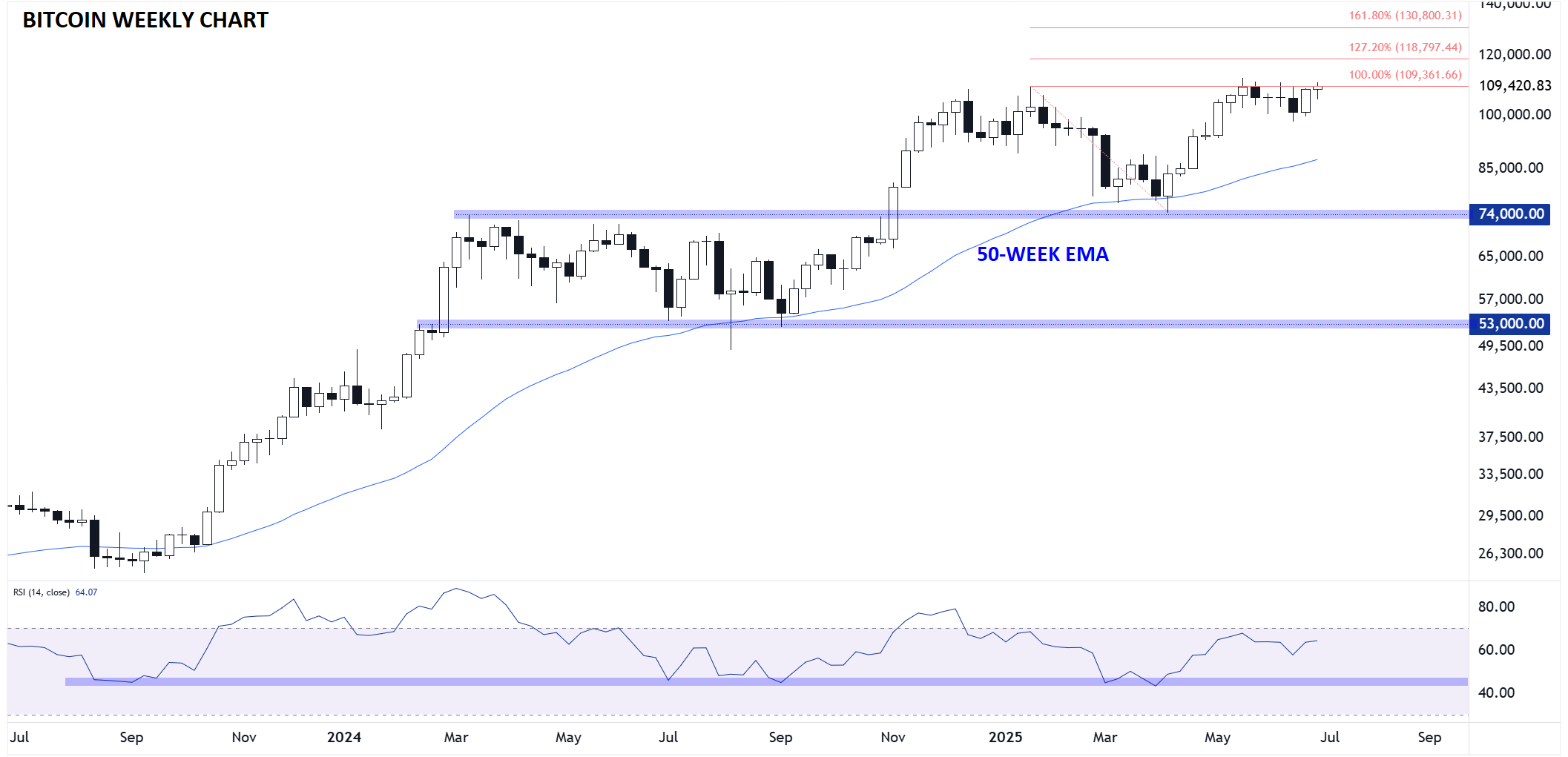
Source: TradingView, StoneX
Looking at the longer-term chart, Bitcoin has rallied back to test the all-time highs near $110K, recovering off the first meaningful pullback of the bull cycle off the 2022 lows. Crucially, even in the depths of that pullback, Bitcoin managed to hold above the 50-week EMA, a dynamic support level that has consistently put a floor under prices for more than two years.
At the same time, the 14-week RSI has consistently held above 45, providing a potential leading/confirming measure for the uptrend’s strength as we head into the second half of the year.
Moving forward, as long as the cryptocurrency holds above the 50-week EMA (currently near $90K), the path of least resistance will remain to the topside for a potential rally to the Fibonacci extensions of this year’s drop near $119K (127.2%) and $131K (161.8%). Only a break below the 50-day EMA and horizontal support near $74K would flip the longer-term trend to neutral.
